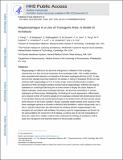| dc.contributor.author | Sullivan, M. P. | |
| dc.contributor.author | Cristofaro, V. | |
| dc.contributor.author | Luo, J. | |
| dc.contributor.author | Lindstrom, J. M. | |
| dc.contributor.author | Pang, Jassia | |
| dc.contributor.author | Borjeson, Tiffany M. | |
| dc.contributor.author | Muthupalani, Sureshkumar | |
| dc.contributor.author | Ducore, Rebecca M. | |
| dc.contributor.author | Carr, Candice A. | |
| dc.contributor.author | Feng, Yan | |
| dc.contributor.author | Fox, James G | |
| dc.date.accessioned | 2015-11-20T13:31:04Z | |
| dc.date.available | 2015-11-20T13:31:04Z | |
| dc.date.issued | 2014-01 | |
| dc.identifier.issn | 0300-9858 | |
| dc.identifier.issn | 1544-2217 | |
| dc.identifier.uri | http://hdl.handle.net/1721.1/99943 | |
| dc.description.abstract | Megaesophagus is defined as the abnormal enlargement or dilatation of the esophagus, characterized by a lack of normal contraction of the esophageal walls. This is called achalasia when associated with reduced or no relaxation of the lower esophageal sphincter (LES). To date, there are few naturally occurring models for this disease. A colony of transgenic (Pvrl3-Cre) rats presented with megaesophagus at 3 to 4 months of age; further breeding studies revealed a prevalence of 90% of transgene-positive animals having megaesophagus. Affected rats could be maintained on a total liquid diet long term and were shown to display the classic features of dilated esophagus, closed lower esophageal sphincter, and abnormal contractions on contrast radiography and fluoroscopy. Histologically, the findings of muscle degeneration, inflammation, and a reduced number of myenteric ganglia in the esophagus combined with ultrastructural lesions of muscle fiber disarray and mitochondrial changes in the striated muscle of these animals closely mimic that seen in the human condition. Muscle contractile studies looking at the response of the lower esophageal sphincter and fundus to electrical field stimulation, sodium nitroprusside, and L-nitro-L-arginine methyl ester also demonstrate the similarity between megaesophagus in the transgenic rats and patients with achalasia. No primary cause for megaesophagus was found, but the close parallel to the human form of the disease, as well as ease of care and manipulation of these rats, makes this a suitable model to better understand the etiology of achalasia as well as study new management and treatment options for this incurable condition. | en_US |
| dc.description.sponsorship | National Institutes of Health (U.S.) (Grant T32OD011141) | en_US |
| dc.description.sponsorship | National Institutes of Health (U.S.) (Grant P30ES002109) | en_US |
| dc.language.iso | en_US | |
| dc.publisher | Sage Publications | en_US |
| dc.relation.isversionof | http://dx.doi.org/10.1177/0300985813519136 | en_US |
| dc.rights | Creative Commons Attribution-Noncommercial-Share Alike | en_US |
| dc.rights.uri | http://creativecommons.org/licenses/by-nc-sa/4.0/ | en_US |
| dc.source | PMC | en_US |
| dc.title | Megaesophagus in a Line of Transgenic Rats: A Model of Achalasia | en_US |
| dc.type | Article | en_US |
| dc.identifier.citation | Pang, J., T. M. Borjeson, S. Muthupalani, R. M. Ducore, C. A. Carr, Y. Feng, M. P. Sullivan, et al. “Megaesophagus in a Line of Transgenic Rats: A Model of Achalasia.” Veterinary Pathology 51, no. 6 (November 1, 2014): 1187–1200. | en_US |
| dc.contributor.department | Massachusetts Institute of Technology. Department of Biological Engineering | en_US |
| dc.contributor.department | Massachusetts Institute of Technology. Division of Comparative Medicine | en_US |
| dc.contributor.department | Picower Institute for Learning and Memory | en_US |
| dc.contributor.department | RIKEN-MIT Center for Neural Circuit Genetics | en_US |
| dc.contributor.mitauthor | Pang, Jassia | en_US |
| dc.contributor.mitauthor | Borjeson, Tiffany M. | en_US |
| dc.contributor.mitauthor | Muthupalani, Sureshkumar | en_US |
| dc.contributor.mitauthor | Ducore, Rebecca M. | en_US |
| dc.contributor.mitauthor | Carr, Candice A. | en_US |
| dc.contributor.mitauthor | Feng, Yan | en_US |
| dc.contributor.mitauthor | Fox, James G. | en_US |
| dc.relation.journal | Veterinary Pathology | en_US |
| dc.eprint.version | Author's final manuscript | en_US |
| dc.type.uri | http://purl.org/eprint/type/JournalArticle | en_US |
| eprint.status | http://purl.org/eprint/status/PeerReviewed | en_US |
| dspace.orderedauthors | Pang, J.; Borjeson, T. M.; Muthupalani, S.; Ducore, R. M.; Carr, C. A.; Feng, Y.; Sullivan, M. P.; Cristofaro, V.; Luo, J.; Lindstrom, J. M.; Fox, J. G. | en_US |
| dc.identifier.orcid | https://orcid.org/0000-0001-9307-6116 | |
| mit.license | OPEN_ACCESS_POLICY | en_US |
| mit.metadata.status | Complete | |
